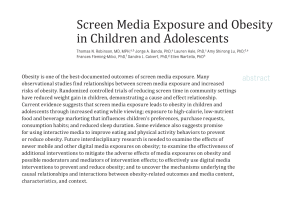Abstract
Obesity is one of the best-documented outcomes of screen media exposure. Many observational studies find relationships between screen media exposure and increased risks of obesity. Randomized controlled trials of reducing screen time in community settings have reduced weight gain in children, demonstrating a cause and effect relationship. Current evidence suggests that screen media exposure leads to obesity in children and adolescents through increased eating while viewing; exposure to high-calorie, low-nutrient food and beverage marketing that influences children’s preferences, purchase requests, consumption habits; and reduced sleep duration. Some evidence also suggests promise for using interactive media to improve eating and physical activity behaviors to prevent or reduce obesity. Future interdisciplinary research is needed to examine the effects of newer mobile and other digital media exposures on obesity; to examine the effectiveness of additional interventions to mitigate the adverse effects of media exposures on obesity and possible moderators and mediators of intervention effects; to effectively use digital media interventions to prevent and reduce obesity; and to uncover the mechanisms underlying the causal relationships and interactions between obesity-related outcomes and media content, characteristics, and context.
This article was published in a special 2017 supplement of Pediatrics, a journal of the American Academy of Pediatrics. The supplement, “Children, Adolescents and Screens: What We Know and What We Need To Learn,” was produced by Children and Screens and includes the contributions of more than 130 interdisciplinary authors across 22 papers. See a complete list of articles included in the supplement.
